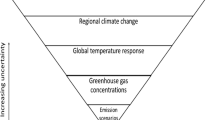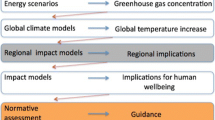Abstract
In public debate surrounding climate change, scientific uncertainty is often cited in connection with arguments against mitigative action. This article examines the role of uncertainty about future climate change in determining the likely success or failure of mitigative action. We show by Monte Carlo simulation that greater uncertainty translates into a greater likelihood that mitigation efforts will fail to limit global warming to a target (e.g., 2 °C). The effect of uncertainty can be reduced by limiting greenhouse gas emissions. Taken together with the fact that greater uncertainty also increases the potential damages arising from unabated emissions (Lewandowsky et al. 2014), any appeal to uncertainty implies a stronger, rather than weaker, need to cut greenhouse gas emissions than in the absence of uncertainty.





Similar content being viewed by others
Notes
PCS, like all other climate sensitivity measures such as the transient climate response (TCR; the expected increase in global temperatures at the time of doubling of CO2 from pre-industrial levels after a 1 %/year increase), is a ratio between expected warming and forcing. Those ratios have been shown to be constant in a linear climate system if forcings grow exponentially (Raupach 2013), implying that an analysis based on PCS likely generalizes to other measures such as TCR.
For tractability and ease of exposition, all estimates relating to the carbon budget in this article are taken from Raupach et al. (2011). Those estimates are consonant with other reviews (e.g., Rogelj et al. 2011). Short-lived gasses such as hydrofluorocarbons do not contribute to the total budget (Smith et al. 2012).
Pacala and Socolow (2004) and Socolow (2011) considered stabilizationof emissions only (i.e., preventing further growth), rather than the cuts to emissions that are necessary to stay within a finite carbon budget. Their analysis thus underestimates the consequences of delayed mitigation, amplifying the point that delay enhances costs.
Lognormal distributions are often characterized by the parameters of the underlying Gaussian distribution, μ G and σ G . They are related to the equivalent parameters of the lognormal distribution via \(\mu _{L} = \exp {(\mu _{G}+.5{\sigma _{G}^{2}})}\) and \(\sigma _{L} = \exp {(\mu _{G}+.5{\sigma _{G}^{2}})} \times \sqrt {\exp {({\sigma _{G}^{2}})}-1}\). All parameter values characterizing lognormal distributions in this article are provided in terms of μ L and σ L .
Note that this involves an inference from the ordinate to the abscissa in Fig. 2; if the function were inverted to show the budget as a function of a temperature response, which is the more routine formulation of Jensen’s inequality, then the function would be convex. For a detailed discussion of the implications of increasing uncertainty in the presence of convex functions, see Lewandowsky et al. (2014).
This asymmetry is exacerbated by the fact that the area below the mean estimate is even greater in our simulation than can be expected in reality: This arises from the intention to keep mean sensitivity ( μ L ) constant across levels of uncertaintyPCS ( σ L ) for our illustrative purposes. In reality, the lower bound of possible climate sensitivities is quite well known and values below 1.5 °C are considered implausible (Meehl et al. 2007). If our simulated distributions of sensitivity were truncated at that lower bound, the asymmetry of the areas representing uncertaintyTR would be further enhanced.
References
Allenby BR, Sarewitz D (2011) We’ve made a world we cannot control. New Sci 210(2812):28–29
Annan JD, Hargreaves JC (2006) Using multiple observationally-based constraints to estimate climate sensitivity. Geophys Res Lett 33:L06704
Brownell KD, Warner KE (2009) The perils of ignoring history: big tobacco played dirty and millions died. How similar is big food?Milbank Q 87:259–294. doi:10.1111/j.1468-0009.2009.00555.x
Freudenburg WR, Gramling R, Davidson DJ (2008) Scientific certainty argumentation method (SCAMs): science and the politics of doubt. Sociol Inq 78:2–38
Freudenburg WR, Muselli V (2013) Reexamining climate change debates: Scientific disagreement or scientific certainty argumentation methods (SCAMs)? Am Behav Sci 57:777–795. doi:10.1177/0002764212458274
Garnaut R (2011) The Garnaut review 2011: Australia in the global response to climate change. Cambridge University Press, Cambridge
Hunter J (2012) A simple technique for estimating an allowance for uncertain sea-level rise. Clim Chang 113:239–252. doi:10.1007/s10584-011-0332-1
Intergovernmental Panel on Climate Change (2005) Guidance notes for lead authors of the IPCC fourth assessment report on addressing uncertainties. (Technical Report)
Jahn D, Korolczuk S (2012) German exceptionalism: the end of nuclear energy in Germany!Environ Polit 21:159–164
Jensen JLWV (1906) Sur les fonctions convexes et les inégalités entre les valeurs moyennes. Acta Mathematica 30:175–193
Kahan DM, Braman D, Slovic P, Gastil J, Cohen G (2009) Cultural cognition of the risks and benefits of nanotechnology. Nat Nanotechnol 4:87–90
Kahan DM, Slovic P, Braman D, Gastil J (2006) Laws of fear: beyond the precautionary principle. Harv Law Rev 119:1071–1109
Kim KS (2011) Public understanding of the politics of global warming in the news media: the hostile media approach. Public Underst Sci 20: 690–705. doi:10.1177/0963662510372313
Lewandowsky S, Risbey JS, Smithson M, Newell BR, Hunter J (2014) Scientific uncertainty and climate change: Part I. Uncertainty and unabated emissions. Clim Chang. doi:10.1007/s10584-014-1082-7
Meehl GA, Stocker TF, Collins WD, Friedlingstein P, Gaye AT, Gregory JM, Zhao Z-C (2007) Global climate projections. In: Solomon S et al. (eds) Climate change 2007: the physical science basis. Contribution of working group I to the fourth assessment report of the intergovernmental panel
Michaels D, Monforton C (2005) Manufacturing uncertainty: contested science and the protection of the public’s health and environment.Am J Publ Health 95: S39–S48. doi:10.2105/AJPH.2004.043059
Narita D (2012) Managing uncertainties: the making of the IPCCs special report on carbon dioxide capture and storage. Public Underst Sci 21:84–100
Nilsson M, Beaglehole R, Sauerborn R (2009) Climate policy: lessons from tobacco control. Lancet:1955–1956
Nisbet MC (2009) Framing science: a new paradigm in public engagement. In: Kahlor L, Stout P (eds) Understanding science: new agendas in science communication. Taylor & Francisb, New York, pp 40–67
Nordhaus WD (2010) Economic aspects of global warming in a post-Copenhagen environment. Proc Natl Acad Sci 107:11721–11726
Oreskes N, Conway EM (2010) Merchants of doubt. Bloomsbury Publishing, London
Pacala S, Socolow R (2004) Stabilization wedges: solving the climate problem for the next 50 years with current technologies. Science 305:968–972
Proctor RN (2004) Should medical historians be working for the tobacco industry?Lancet 363:1174–1175
Proctor RN (2008) On playing the Nazi card. Tob Control:289–290
Raupach MR (2013) The exponential eigenmodes of the carbon-climate system, and their implications for ratios of responses to forcings. Earth Syst Dyn 4:31–49
Raupach MR, Canadell JG, Ciais P, Friedlingstein P, Rayner PJ, Trudinger CM (2011) The relationship between peak warming and cumulative CO2 emissions, and its use to quantify vulnerabilities in the carbon-climate-human system. Tellus 63B:145–164
Roe GH, Baker MB (2007) Why is climate sensitivity so unpredictable?Science 318:629–632
Rogelj J, Hare W, Lowe J, van Vuuren DP, Riahi K, Matthews B, Meinshausen M (2011) Emission pathways consistent with a 2° C global temperature limit. Nat Clim Chang. doi:10.1038/NCLIMATE1258
Sarewitz D (2004) How science makes environmental controversies worse. Environ Sci Policy 7:385–403
Slovic P (1987) Perception of risk. Science 236:280–285
Slovic P (1999) Trust, emotion, sex, politics, and science: Surveying the risk- assessment battlefield. Risk Anal 19:689–701
Smith P, Bansal-Travers M, O’Connor R, Brown A, Banthin C, Guardino-Colket S, Cummings K (2011) Correcting over 50 years of tobacco industry misinformation. Am J Prev Med 40:690–698
Smith SM, Lowe JA, Bowerman NHA, Gohar LK, Huntingford C, Allen MR (2012) Equivalence of greenhouse-gas emissions for peak temperature limits. Nat Clim Chang 2:535–538. doi:10.1038/NCLIMATE1496
Socolow R (2011) Wedges reaffirmed. Bulletin of the atomic scientists, (web edition)
Solomon S, Plattner G-K, Knutti R (2009) Irreversible climate change due to carbon dioxide emissions. Proc Natl Acad Sci USA 106:1704–1709. doi:10.1073/pnas.0812721106
Stern N (2007) The economics of climate change: the Stern review. Cambridge University Press, Cambridge
Sterner T, Persson UM (2008) An even Sterner review: introducing relative prices into the discounting debate. Rev Environ Econ Policy 2:61–76
Tol RSJ (2011) The social cost of carbon. Ann Rev Resour Econ 3:419–443
Tomassini L, Knutti R, Plattner G-K, van Vuuren DP, Stocker TF, Howarth RB, Borsuk ME (2010) Uncertainty and risk in climate projections for the 21st century: comparing mitigation to non-intervention scenarios. Clim Chang 103:399–422. doi:10.1007/s10584.009.9763.3
Vlek C (2010a) Judicious management of uncertain risks: I. Developments and criticisms of risk analysis and precautionary reasoning. J Risk Res 13:517–543
Vlek C (2010b) Judicious management of uncertain risks: II. Simple rules and more intricate models for precautionary decision-making. J Risk Res 13: 545–569. doi:10.1080/13669871003629903
Webster M, Forest C, Reilly J, Babiker M, Kicklighter D, Mayer M (2003) Uncertainty analysis of climate change and policy response. Clim Chang 61: 295–320. doi:10.1023/B:CLIM.0000004564.09961.9f
Acknowledgments
Preparation of this paper was facilitated by a Discovery Grant from the Australian Research Council, an Australian Professorial Fellowship, a Discovery Outstanding Researcher Award, and a Wolfson Research Merit Award from the Royal Society, to the first author, by a Future Fellowship from the Australian Research Council to Ben Newell, and funding from the Australian Research Council Centre of Excellence in Climate Systems Science. The work was also supported by a Linkage Grant from the Australian Research Council and a grant from the National Climate Change Adaptation Research Facility and the CSIRO Climate Adaptation Flagship. We thank four reviewers for their incisive critique and helpful comments. Correspondence to the first author at the School of Experimental Psychology, University of Bristol, 12A Priory Road, Bristol BS8 1TU, United Kingdom (stephan.lewandowsky@bristol.ac.uk). Personal web page: http://www.cogsciwa.com.
Author information
Authors and Affiliations
Corresponding author
Additional information
Part I of this paper is published under doi:10.1007/s10584-014-1082-7.
Rights and permissions
About this article
Cite this article
Lewandowsky, S., Risbey, J.S., Smithson, M. et al. Scientific uncertainty and climate change: Part II. Uncertainty and mitigation. Climatic Change 124, 39–52 (2014). https://doi.org/10.1007/s10584-014-1083-6
Received:
Accepted:
Published:
Issue Date:
DOI: https://doi.org/10.1007/s10584-014-1083-6




